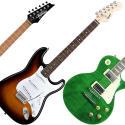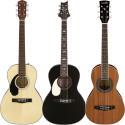Understanding Guitar Sizes for Different Sounds and Uses
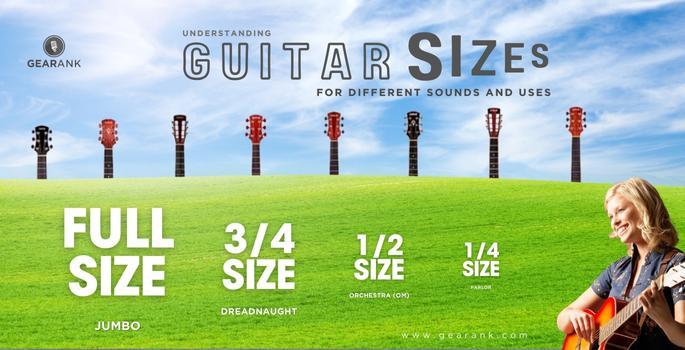
You've probably wondered why there are so many different guitar sizes and what is the difference.
Does guitar size matter, does it affect sound and playability? Are there sizes that work well with specific musical styles?
We'll answer all these questions while taking a closer look at the different guitar sizes and their impact on overall playing experience.
We'll talk about:
-
Scaled-Down (Short Scale) Guitars
-
Full Size Guitars
-
Why Does Guitar Sizes Matter?
-
How To Measure Guitar Size?
-
Tips for Choosing The Right Guitar Size
By the end, you'll be able to tell which guitar sizes are which, and you'll know which sizes fit you best.
There are so many different sizes and shapes available, but for simplicity, they can be classified into two main size groups: Full Size and Scaled-Down Sizes. This principle applies to the most popular acoustic guitars, classical guitars, and electric guitars.
I. Scaled-Down (Short Scale) Guitars
Scaled-down guitars are smaller versions, usually having the shape of a full-size guitar, but made smaller. Aside from scaled down bodies, many of these smaller guitars have short scale length necks.
1. 1/4 Size Guitar (Tuned in A standard) and 1/2 Size Guitar (Tuned in E standard).
These are some of the smallest scaled-down sizes available that are still playable. As the name implies, they can be 1/4 or 1/2 the size of a regular guitar.
These small instruments are meant to inspire toddlers and young rising stars. They are a great choice for those seeking a compact and comfortable instrument to learn the ropes.
| Age: | 3-5 years old | Age: | 5-8 years old |
| Ideal Height: | 75-115 cm (about 2'4'' - 3'9") tall | Ideal Height: | 115-135 cm (about 3'10'' - 4'5") tall |
| Scale Length: | 480mm (about 19"-20") | Scale Length: | 535 mm (about 21"-22") |
2. 3/4 Size Guitar (Tuned in E standard)

This size is closer to a regular guitar while still being substantially smaller. This makes transitioning to a full-size guitar easier. This is the ideal size for kids, but it can be played by adults as well.
I, for one, find myself reaching out for my son's 3/4 size nylon string guitar occasionally because it is very comfortable to play.
| Age: | 4-12 years old | Age: | 12 years old and above |
| Ideal Height: | 135 cm - 150 cm (about 4'6'' - 4'11") | Ideal Height: | 150 cm or taller (about 5' up) |
| Scale Length: | 580 mm (about 22.8"-24") | Scale Length: | 650 - 660 mm (about 25.6" - 26") |
II. Full-Size Guitars
As the name implies, this section features full-sized guitars. This is the most common, and is also called standard guitar size. Electric guitars are a bit more simple, but acoustic guitars have a long list of size and shape variations.
1. Full-Size Acoustic Guitars
Given their hollow wooden body and shape, acoustic guitars are generally bulky instruments. But there are different acoustic guitar sizes, depending on body styles, shape, and design.
In this section, you'll learn about the common full-size acoustic guitar shapes, their common dimensions, and the styles of music that they are often utilized. Note that featured here are acoustics with steel strings, classical and nylon string guitars have their own section.
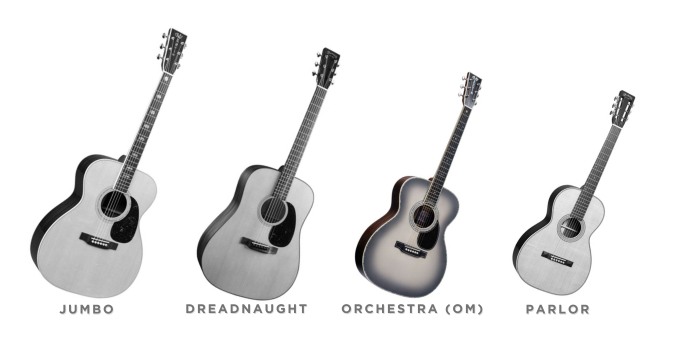
A. Dreadnought Guitars
Dreadnoughts are classic steel-string acoustic guitars. This is the first shape that comes to mind when most people think of acoustic guitars.
They have a large body size, designed to produce a louder sound, especially during the times before guitar amplification. Due to their size, these guitars can be initially challenging for smaller players, but they can get used to its size. I've taught many young students on dreadnoughts with no issue.
A dreadnought acoustic guitar has a warmer tone with a rich low end. It also has scooped mids, which adds to the depth of its sound.
They work well with vocals, which is why singer-songwriters primarily prefer them. These guitars are best suited for strumming but can also be used for fingerpicking as well.
Dimensions: Scale length 20”, width 15 ⅝”, thickness 4 ⅞”, total length 40 ¾”.
General dimensions: 20” long, 4” deep, 11 1/2" upper body width, 15" lower body width.
B. Orchestra Model, AKA "OM"
Orchestra models are slightly smaller than dreadnought guitars. These guitars also have a slightly thinner body compared to other larger guitars.
It can be differentiated with its curvy midsection, which makes it a bit more comfortable to play, but not by a big margin.
When it comes to tone, Orchestra guitars produce a more balanced and warmer sound, with less low end thump, but clearer treble notes and balanced mids. It is a midway point size acoustic guitar with tones that are ideal for various uses. This versatile instrument shape works well with strumming, fingerpicking, and fingerstyle.
Other variants of this shape include grand concert guitars, grand performance guitars, and grand auditorium guitars. Naming and specifications change depending on the manufacturer.
Dimensions: Scale length 19”, width 15”, thickness 4 ½”, total length 40”.
C. Jumbo Guitars
The biggest of the full-sized acoustic guitars, these jumbo guitars have an enormous body. With their bulky build, they're usually heavy to move around.
A jumbo acoustic guitar produces a massive sound with wide dynamic range, along with a enhanced bass response, giving it a deep, rich tone, similar to its body.
Jumbo guitars are best for strummed rhythm sections. They're often seen in folk rock and country music, which prefer their deep tone.
While they are bigger, but not by a big margin. So you don't have to be tall, or big to be able to play a jumbo guitar comfortably.
The Dimensions: Scale length 20 3/4”, width 17”, thickness 4 1/4”, total length 41 1/2″.
General dimensions: 20" long, 4" deep, over 11" upper body width, over 16" lower body width.
D. Parlor Guitars
They are the smallest among the full-size guitars. Parlor guitars were very popular, especially when playing guitar was mostly done at home and didn't need a loud sound.
It has a slim body and midsection, which makes it easier to play.
While parlor guitars are technically full-size instruments, their actual size and dimensions are similar to scaled down instruments, some as small as 3/4 and 1/2 scale guitars.
Folk musicians and those seeking a vintage style focused sound frequently use parlor guitars, which have a rich, midrange tone. They're commonly used for fingerpicking and fingerstyle playing.
These smaller body guitars are also preferred for their compact body shape and old school appeal.
Dimensions: Scale length 18 1/4”, width 12 7/8”, thickness 4 ¼”, total length 37 1/2”.
General dimensions: 18 1/4" or less long, 4" deep, 9 1/2" or less upper body width, 13 1/4" or less lower body width.
Note: Manufacturers have their own sizing standards, so dimensions can vary depending on the brand and model.
2. Full-Size Classical Guitars
Throughout the years, you'll notice that classical guitars maintain almost the same size and design. This is mainly due to the cultural and historical traditions of the instrument.
A classical guitar was designed to play classical music. It has nylon strings and a flat, wide fretboard. producing a warm and balanced tone.
These characteristics are what's expected from classical guitars. For this reason, its full-size guitars follow a stricter standard across different makers.
There are variants called nylon string guitars, these can come in different shapes and aren't tied to the traditional classical guitar playing style.
3. Full-Size Electric Guitars
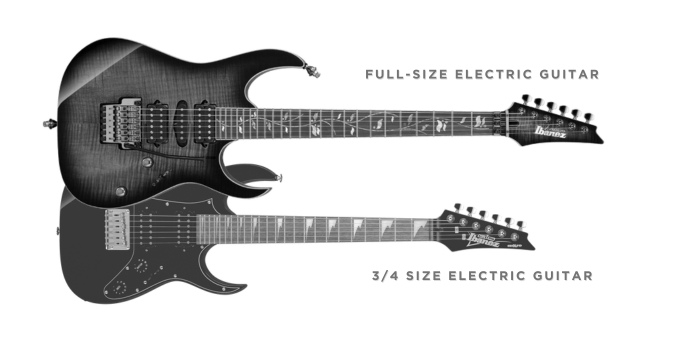
Electric guitars rely on pickups and amps instead of the guitar's body for resonance and amplification. This means a guitar's total length has little effect on the instrument's tone and feel.
This is the reason why solid body electric guitars tend to have thinner, slimmer bodies. It also explains how electric guitars can get away with so many variations in shapes and sizes.
There are currently a lot of electric guitars on the market; but the three major guitar types are the Les Paul, Stratocaster, and Telecaster.
And these popular shapes have scaled down versions, usually 3/4 sized for kids.
Other popular solid body electric guitar shapes are the Flying V, SG, Superstrat, and other offset guitars like Fender's Jazzmaster, Gibson's Firebird, or Ibanez's Iceman.
Note that there are hollow body electric guitars with deeper body depth.
4. Other Guitars & Ukulele
-
Guitalele (AKA, Guitarlele, Guilele, or Kīkū): A guitalele is almost the same size as a baritone ukelele in terms of size. They're tuned in A standard, or 5 frets higher than a regular guitar tuning. Given its small size, it features a bright, trebly, and thin tone.
-
Travel: Travel guitars are among the smallest guitars. They're designed to be lightweight and easy to carry—perfect for traveling.
Unlike a smaller, full-sized guitar like a parlor, travel guitars have a small body with a scale length that is adjusted proportionately. However, some travel guitars also have a full-sized scale for consistent playability, while having a miniature body.
-
Ukelele: This 4 string instrument may look like a steel-string acoustic guitar, but in reality, it's not.
For starters, ukeleles evolved from Portuguese instruments like braguinha and machete, whereas guitars drew inspiration from lutes and ouds.
Just like guitars, ukuleles have different variations as well. The image of a ukelele that people have in mind is actually the "soprano" ukelele, but there are bigger and smaller versions available.
Ukeleles are tuned to G-C-E-A. This is similar to the four higher strings of a guitar when you capo on the 5th fret.
Why Does Guitar Size Matter?
Now that we know the different sizes, let's tackle the question of purpose. Why do guitars come in different sizes? I will qualify my answer based on three major aspects of guitar playing, playability, tone, and portability.
Playability: Comfortability affects the way you play any instrument. It's crucial to match your specific body type to your instrument to play comfortably. This is the reason why different-scale guitars exist.
For kids, scaled-down size guitars give them the opportunity to play even at an early age without having to wrestle with a large guitar. For adults, this gives you the option to experiment with other guitar sizes that you'll feel more comfortable in.
As a beginner, being able to play a guitar that is easy on the hands would encourage you to practice and learn more. Meanwhile, if you're an intermediate-to-advanced player, better playability can help increase the level of your playing.
Tone: Another factor in why guitar sizes matter is the tonal difference of each variation. This is more pronounced on hollow bodies. Sound waves resonate differently depending on how big or small the body is. This is the reason why bigger acoustic guitars sound fuller and have more bass, while smaller ones have more defined mids.
Portability: Portability is another important factor to consider. Some musicians need compact and easy-to-carry guitars to match their on-the-go lifestyles. While others have a travel guitar ready in case they have to go away for days at a time.
How To Measure Guitar Size?
There are several factors that can affect a guitar's playability and sound. Compared to others, these two features have a greater effect on a guitar's feel and tone.
Guitar Scale Length
The scale length is a good way to measure guitar size. To measure scale length, measure the distance of the strings from the nut to the middle of the 12th fret, then multiply by 2.
Scale length is a very important factor in choosing guitar sizes. Aside from affecting its overall length, scale length determines a guitar's string tension and tone, among others. Getting the right scale length the first time is crucial, as it's a feature that cannot be easily adjusted.
Guitar Total Length
The total length of a guitar is measured all the way from the top of the headstock to the base of the body. Different guitar brands play around with the headstock sizing. Some will have it quite small, others large, some at a strange angle, or some without.
The total length of a classical or acoustic guitar can affect its tonal characteristics, especially its body. A big guitar body means a louder sound and a warmer, more low-end tone, while a smaller body has a lower output and a brighter, more trebly tone.
In contrast, the total length of an electric guitar has a very small effect on the instrument's tone and feel. That is why manufacturers have the freedom to play with headstocks and body shape.
Other Body Features
-
Nut Width: The nut width is the width of the nut at the top of the guitar neck. Use a caliper or ruler to measure the width of the nut from one edge to the other.
-
Neck Width: For a more accurate representation of the neck's taper, measure the width of the neck at the nut and at the 12th fret.
-
Lower and Upper Bout Width: The lower bout is the wider, lower part of the guitar body. The upper bout refers to its smaller counterpart. To get its width, measure each one at its widest point.
-
Thickness: For body thickness, measure the depth of the body at its thickest point, usually around the center or lower bout.
For neck thickness, measure the depth of the neck from the back of the neck to the front, typically around the 1st fret. This applies regardless if you have a mahogany neck, maple neck, or any other wood type.
Tips for Choosing The Right Guitar Size
The best way to understand a guitar's size is to go and play it. Here are some tips on how to know if a guitar is right for you.
-
First, you want to sit with the guitar for a moment. Consider how it feels on your body, knees, and hands and what the weight is like. Also, check if you can reach the playing area (where you'll strum or pluck the strings) without much effort. Make sure the guitar fits you well.
-
Next, get a feel for the frets. You should be able to reach both the lower and higher frets. Ensure you can wrap your hands around the neck and reach the first fret. The movement should be relatively easy.
-
Finally, consider the tone. The guitar needs to suit the style of music you intend to play. You can see it from both an aesthetic and practical perspective.
Electric and acoustic guitars have varying dimensions and designs. For electric guitars, you can choose a design that matches the genre you play.
For an acoustic guitar, if you want a louder sound with a rich and deep tone, consider those with a bigger body. If you prefer a warmer sound with a brighter tone, look for something smaller.
Final Thoughts
Guitar sizes can be narrowed down into two main groups full-sized guitars and scaled-down guitars.
Scaled-down guitars include 1/4, 1/2, 3/4, 7/8 scale guitars that are smaller and easier to play with. While full-sized guitars are the standard sizes that manufacturers originally determined for their instruments.
For kids or for petite adults, a smaller guitar is more fitting. Most adults will have no issues with a full-sized guitar, and you also get the full benefit from its specs and feature set.
Use this article as a reference in case you want to try a different size guitar, or you're planning to buy one for someone else.
Ready to buy a guitar? Check out our review on beginner guitars.
Frequently Asked Questions
What Age Can A Child Begin On Guitar?
Children from 3-5 years old may show interest in playing the instrument. However, it's mainly because of curiosity and fun.
A lot of children can have formal lessons when they're 6–8 years old. This age group tends to have a longer attention span and can learn simple chords and songs.
But the best age for structured guitar lessons is 9 or up. At this stage, a child can already handle more complex instructions, like chord progressions and techniques.
What is The Best Beginner Guitar Size?
In terms of feel, choose a guitar with a neck that you can easily grip and a fretboard that can accommodate the size of your fingers.
With regards to tone, choose the one that sounds good to your ears. You can also factor in the preference of the artist that you like. For example, Ed Sheeran with his 3/4 Martin LX1 (modified O) or John Mayer's Martin OMJM.
Can I Change From Small To A Full Size Guitar?
Your choice of guitar size can evolve based on your preferences and playing style. When you're still starting to learn, you can opt for a smaller guitar. As you progress and grow in experience, you can choose to change into a different-sized guitar. The reverse is also possible, some experienced musicians end up switching to smaller instruments for the comfort and sometimes for tone.
Take note of the string's tuning. Some smaller guitars are tuned differently to compensate for their shorter scale length.
If you're aiming to transition from a small to a big guitar, I suggest that you start with a guitar that can at least be tuned similarly to a full-sized one.
Contributors:
- Jerome Arcon - Co-writer





